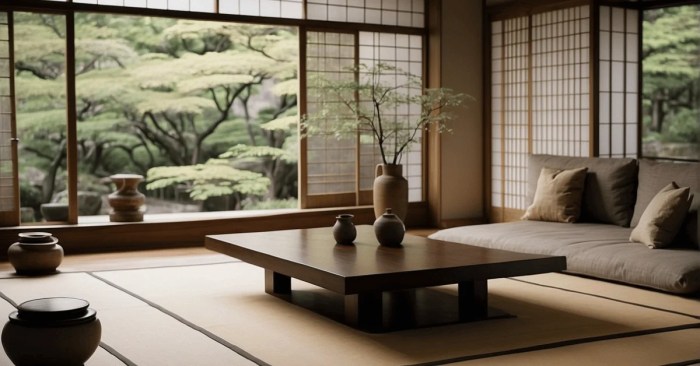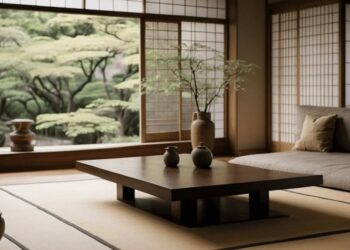Embark on a journey into the world of Japanese minimalist interior design with our comprehensive guide. Discover the essence of simplicity, functionality, and tranquility that defines this aesthetic style.
Introduction to Japanese Minimalist Interior Design
Japanese minimalist interior design is a design approach that focuses on simplicity, minimalism, and functionality. It is characterized by clean lines, uncluttered spaces, and a sense of tranquility. This design style is heavily influenced by traditional Japanese aesthetics and Zen philosophy.
Key Elements of Japanese Minimalist Interior Design
Japanese minimalist interior design incorporates the following key elements:
- Neutral color palette: Colors such as white, beige, and grey are commonly used to create a sense of calm and simplicity.
- Natural materials: Wood, bamboo, and stone are often used in Japanese minimalist interiors to bring a sense of nature indoors.
- Functional furniture: Furniture pieces are typically simple in design and serve a practical purpose, with no unnecessary embellishments.
- Minimalist decor: Decorative items are kept to a minimum to avoid clutter and maintain a sense of openness.
Philosophy Behind Japanese Minimalist Interior Design
Japanese minimalist interior design is rooted in the principles of Zen Buddhism, which emphasize the importance of simplicity, mindfulness, and harmony. The goal is to create spaces that promote a sense of peace, balance, and serenity. By focusing on essential elements and removing excess, Japanese minimalist interior design encourages a deeper connection with the environment and a more mindful way of living.
Color Scheme and Materials
In Japanese minimalist interior design, the color palette is typically centered around neutral tones such as whites, beiges, grays, and browns. These colors create a sense of simplicity, tranquility, and sophistication in the space.The materials commonly used in Japanese minimalist interior design include natural elements like wood, bamboo, stone, and paper.
These materials not only add texture and warmth to the space but also connect the indoors with the natural world outside.
Color Palette
- Whites, beiges, grays, and browns dominate the color scheme.
- Accents of black or darker shades may be used sparingly to create contrast.
- Soft pastel colors like light blues or pale greens can be incorporated for a touch of color.
Materials
- Wood is a key material, often used for flooring, furniture, and architectural elements.
- Bamboo is utilized for decor accents, furniture, and window treatments.
- Stone is used for countertops, flooring, and sometimes accent walls.
- Paper screens and shoji doors are common to partition spaces and allow natural light to filter through.
The color scheme and materials in Japanese minimalist interior design work harmoniously to create a serene and peaceful atmosphere, promoting a sense of balance and simplicity in the space.
Furniture and Layout

Japanese minimalist interior design is known for its carefully selected furniture pieces and layout that prioritize simplicity and functionality. Let's explore the key elements that contribute to the serene and uncluttered aesthetic of Japanese minimalist interiors.
Furniture Pieces
In Japanese minimalist interiors, furniture pieces are typically low to the ground and feature clean lines and simple designs. Some common furniture pieces found in these spaces include:
- Low wooden tables: These tables are often used for dining or as a coffee table in the living room. They are usually made from natural materials such as wood or bamboo.
- Futons or low platform beds: Sleeping arrangements in Japanese minimalist interiors often involve futons placed directly on the floor or low platform beds to create a sense of closeness to the ground.
- Shoji screens: These traditional Japanese sliding doors are used to divide spaces and add a touch of elegance to the interior.
- Minimalist seating: Floor cushions, tatami mats, and simple chairs without excessive padding are commonly used for seating in Japanese minimalist interiors.
By choosing furniture pieces with simple designs and natural materials, Japanese minimalist interiors create a sense of calm and tranquility.
Layout Principles
The layout in Japanese minimalist interiors follows a few key principles to enhance the sense of simplicity and functionality:
- Open floor plans: Spaces are often open and uncluttered to create a sense of flow and spaciousness.
- Multi-functional spaces: Rooms are designed to serve multiple purposes, with furniture that can be easily moved or stored away to adapt to different activities throughout the day.
- Minimalist decor: Decorative elements are kept to a minimum to allow the furniture and layout to take center stage.
- Natural light: Large windows and light-colored walls are used to maximize natural light, creating a bright and airy atmosphere.
By following these layout principles, Japanese minimalist interiors achieve a harmonious balance between simplicity and functionality.
Lighting and Nature Elements
In Japanese minimalist interior design, lighting and nature elements play a crucial role in creating a serene and harmonious environment.
Natural Light
Natural light is highly valued in Japanese minimalist interiors as it helps to create a sense of openness and connection to the outdoors. Large windows, skylights, and strategically placed openings allow sunlight to flood the space, creating a warm and inviting atmosphere.
Nature Elements
Indoor plants and natural textures are often incorporated into Japanese minimalist interiors to bring a touch of nature indoors. Plants not only add a pop of greenery but also help to purify the air and promote a sense of tranquility.
Natural materials like wood, stone, and bamboo are used to add warmth and texture to the space, enhancing the overall aesthetic.
Harmonious Environment
By combining natural light, indoor plants, and natural textures, Japanese minimalist design achieves a harmonious balance between the indoors and outdoors. The interplay of light and nature elements creates a peaceful and calming environment that promotes relaxation and mindfulness.
Decluttering and Organization
In Japanese minimalist interior design, decluttering and organization play a crucial role in creating serene and harmonious spaces. By following key principles of minimalism, you can achieve a clean and clutter-free environment that promotes a sense of calm and tranquility.
Decluttering Tips
- Start by decluttering one room at a time to avoid feeling overwhelmed. Sort items into categories such as keep, donate, or discard.
- Embrace the concept of "less is more" by only keeping items that serve a purpose or bring joy. Let go of unnecessary belongings to create more breathing space.
- Utilize storage solutions such as hidden cabinets, shelves, and multi-functional furniture to keep surfaces clear and visually appealing.
Organization and Storage Solutions
- Opt for sleek and simple storage solutions that blend seamlessly with the overall design aesthetic. Choose furniture with built-in storage options to maximize space.
- Implement a systematic approach to organizing belongings by assigning specific areas for each item. Labeling storage containers can also help maintain order.
- Invest in high-quality storage bins, baskets, and organizers to keep smaller items neatly tucked away. Transparent containers can make it easier to locate items quickly.
Maintaining a Clutter-Free Environment
- Establish a daily decluttering routine to prevent items from piling up. Take a few minutes each day to tidy up and put things back in their designated places.
- Regularly assess your belongings and consider letting go of items that no longer serve a purpose. Embrace a minimalist mindset to avoid unnecessary accumulation.
- Encourage household members to adopt minimalist habits by leading by example. Create designated storage spaces for each individual to maintain organization.
Final Wrap-Up
In conclusion, Japanese minimalist interior design offers a harmonious blend of minimalism and nature, creating spaces that exude peace and balance. Embrace this timeless design philosophy to transform your living environment into a tranquil haven.
Commonly Asked Questions
How can I incorporate Japanese minimalist design in a small space?
To maximize space in a small area, opt for multi-functional furniture pieces and keep the color palette light and neutral to create a sense of openness.
What are some key elements to consider when decorating in Japanese minimalist style?
Focus on clean lines, natural materials, and incorporating elements of nature like bamboo or indoor plants to achieve an authentic Japanese minimalist look.
Is it necessary to get rid of all my belongings to achieve a minimalist look?
Minimalism is more about intentional living and decluttering rather than getting rid of everything. Keep items that bring you joy and serve a purpose in your space.




